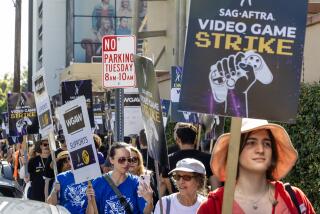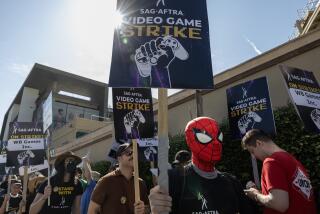Will SAG get it on the next take?
After nearly 10 months without a contract, you might think that the Screen Actors Guild’s board would be relieved to finally have a tentative deal with the major Hollywood studios. Instead, as has been SAG’s custom of late, the negotiating team’s proposal divided the board, with President Alan Rosenberg leading a sizable minority in opposing it. And no wonder -- the deal falls well short of what SAG’s leadership promised last year. But the question for guild voters isn’t just whether they can live with this agreement; it’s whether they think SAG can persuade the studios to do better.
It’s not our place to tell union members how to vote; besides, what’s best for one group may not be for another. Like the industry in general, active film actors have been hurt by the slowdown in major new productions during the impasse. But television day-players may be tempted to hold out for better residuals when shows are aired online, given how much of their income has come from residuals for TV reruns.
Nevertheless, it’s worth pointing out that the challenge for SAG is the same as the one facing the entertainment industry: how to adapt to a digital world with more fragmented audiences and more competition. A 20th century business model is not an option. That’s why it’s imperative for SAG and the studios to maintain their ability to experiment and learn online. In some provisions, such as movies downloaded or streamed online for a fee, the proposed two-year deal offers actors a bigger share of the sales than they receive from DVDs. In others, the terms are significantly worse than the ones for their analogues in traditional media. Which of these approaches, if any, will take the place of conventional TV or film distribution is anybody’s guess.
The long stalemate cost SAG members tens of millions of dollars they would have received from traditional media sources (in the form of increased wages and benefits) while the union pursued better terms for new media, which can’t produce anything close to that amount of money in the short term. Rosenberg and other SAG hard-liners argued that any sacrifices made today in new media would come to haunt them once the Internet becomes the dominant form of distribution. Their position is supported by SAG’s experience with the studios on cable TV, VHS and DVD -- low initial residuals never gave way to larger shares. But SAG’s leverage was undermined by the willingness of other unions to accept less and the internal SAG conflicts that were on display almost from the start of contract talks. Those conflicts led moderates to take control of the board and put their own negotiators in place in January.
The most important aspect of the tentative deal is that it would expire about the same time as the ones for SAG’s sister union, the American Federation of Television and Radio Artists, and the Writers Guild of America. Negotiating jointly with AFTRA, in coordination with the Writers Guild, would certainly put SAG in a better bargaining position. There’s no guarantee that the additional clout would be enough to secure better terms for new media and other disputed issues. But if there’s one thing everyone at SAG can agree on, it’s that the union needs more leverage the next time around.
More to Read
A cure for the common opinion
Get thought-provoking perspectives with our weekly newsletter.
You may occasionally receive promotional content from the Los Angeles Times.










